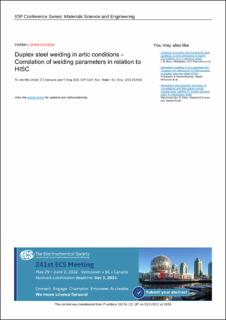| dc.contributor.author | Czarnacki, Ziemowit | |
| dc.contributor.author | Xing, Yihan | |
| dc.date.accessioned | 2022-01-14T12:15:41Z | |
| dc.date.available | 2022-01-14T12:15:41Z | |
| dc.date.created | 2021-11-23T20:48:28Z | |
| dc.date.issued | 2021 | |
| dc.identifier.citation | Czarnacki, Z., Xing, Y. (2021) Duplex steel welding in artic conditions – Correlation of welding parameters in relation to HISC. IOP Conference Series: Materials Science and Engineering, 1201, 012016 | en_US |
| dc.identifier.issn | 1757-8981 | |
| dc.identifier.uri | https://hdl.handle.net/11250/2837449 | |
| dc.description.abstract | Duplex steel is an austenitic-femtic steel alloy commonly used in the offshore and subsea oil and gas industry. Duplex steel provides a unique combination of good mechanical properties and corrosion resistance in sweet and sour hydrocarbon environment, as well as in seawater. However, the combination of tensile loading, post-weld residual stresses, cathodic protection and other factors related to subsea implementation significantly increase the probability of hydrogen induced stress cracking (HISC). This paper aims to find a relationship between the formation of residual stresses and the imperfection of the welding process carried out on Duplex steel in extremely cold conditions. Based on a finite element (FE) welding transient simulation from a thermal perspective, the correlation between the welding parameters and heat distribution is established and analysed when the welding takes place in the cold arctic conditions. Pearson parameter correlation analysis method will be used to investigate the impact of extreme ambient temperatures on the welding process. The results and conclusions provide a solid foundation for welding process optimization in connection with HISC. | en_US |
| dc.language.iso | eng | en_US |
| dc.publisher | IOP Publishing | en_US |
| dc.rights | Navngivelse 4.0 Internasjonal | * |
| dc.rights.uri | http://creativecommons.org/licenses/by/4.0/deed.no | * |
| dc.subject | petroleumsteknologi | en_US |
| dc.subject | stål | en_US |
| dc.title | Duplex steel welding in artic conditions – Correlation of welding parameters in relation to HISC | en_US |
| dc.type | Peer reviewed | en_US |
| dc.type | Journal article | en_US |
| dc.description.version | submittedVersion | en_US |
| dc.subject.nsi | VDP::Teknologi: 500 | en_US |
| dc.source.volume | 1201 | en_US |
| dc.source.journal | IOP Conference Series: Materials Science and Engineering | en_US |
| dc.identifier.doi | 10.1088/1757-899X/1201/1/012016 | |
| dc.identifier.cristin | 1958158 | |
| dc.source.articlenumber | 012016 | en_US |
| cristin.ispublished | true | |
| cristin.fulltext | postprint | |
| cristin.qualitycode | 1 | |

